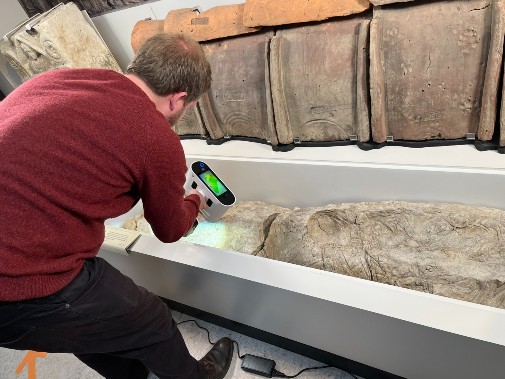Archaeologists in York have utilized state-of-the-art 3D scanning technology to delve into the secrets of a 1,700-year-old Roman burial practice involving liquid gypsum.
This pioneering application of 3D scanning to Roman burials has yielded unprecedented insights into this enigmatic and distinctive funerary custom.

Sign of High Status
The Romans occasionally poured liquid gypsum, a mineral used in cement and plaster, over the bodies of clothed adults and children before interring them in lead or stone coffins.
As the gypsum hardened and the bodies decomposed, negative impressions formed, preserving the original contours and positions of the deceased.
The gypsum also retained imprints of shrouds, clothing, and footwear, providing valuable evidence of perishable materials that were rarely found in Roman graves.
Although the exact reasons for this ritual remain unclear, researchers believe it was associated with individuals of high status.
Traces of aromatic resins from the Mediterranean and Arabia discovered in three gypsum burials in York suggest the use of expensive and exotic substances in clothing and wrappings, indicating a practice reserved for the elite.
While various types of gypsum burials have been identified in Europe and North Africa, the concentration of at least 45 such burials in and around York distinguishes Britain as a significant location for this burial tradition.
The Yorkshire Museum possesses the largest and most significant collection of gypsum burial casts from Britain, making it a crucial partner in the project conducted by the University of York, York Museums Trust, and Heritage360. Sixteen of these gypsum casings, now 3D-scanned, were used in the York project.
The centerpiece of the project involves scanning the negative cavities within the gypsum casings. The researchers selected a casing that contained the remains of a family-a pair of adults and an infant who had passed away simultaneously.
Professor Maureen Carroll, Chair of Roman Archaeology at the University of York, described the 3D images as an opportunity to witness a poignant family tragedy from nearly 2,000 years ago, highlighting both the fragility of life in antiquity and the care invested in the interment of this group.
Wrapped in Shrouds
The 3D models reveal that all members of the family were completely wrapped in shrouds and textiles of varying quality and weave before being buried and covered by liquid gypsum.
Details such as the ties securing the burial shroud over the head of one adult and the bands of cloth used to swaddle the infant are clearly visible.
Funded by the University of York and carried out by the Department of Archaeology, York Museums Trust, and Heritage360, the project has introduced cutting-edge technologies that allow the public to engage with the museum's collections in exciting new ways.
The 3D scans of the family burial group offer a poignant encounter with a tragic event that occurred over 1,600 years ago in York.
The project team aims to secure substantial research funding to scan all the York gypsum casings and skeletons to determine their age, sex, diet, and geographic origins.
They also seek to gain a deeper understanding of the textiles used in the burials, exploring their social significance and the cultural, ritual, or practical reasons behind this distinct method of handling the deceased, not only in York but throughout Britain and beyond.

ⓒ 2025 TECHTIMES.com All rights reserved. Do not reproduce without permission.




